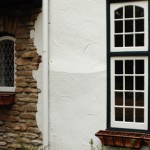Older buildings with stucco surfaces require periodic stucco repair to maintain the integrity of the original building exterior surface. Tudor style homes which became popular during the first half of the 1900’s had a mixture of stucco, wood and masonry. When an inspection is performed on these structures there are usually several areas that have cracks, delaminations and bulges that may require a stucco repair.
Most of the damage we’ve seen that require a stucco repair are from bulged surfaces areas. Why does this happen?
The reasons aren’t not always the same but generally speaking, sections of the exterior surface where the finish bulges out from the surrounding surface material is actually pulling away from the framing of the structure. This can occur in areas where cracks have opened do to age, leaking downspouts, water infiltration, failed anchors or structural defects, etc. This allows excessive moisture to migrate into the wall system and over time the constant movement of the surface material during the freeze thaw cycle eventually delaminates the stucco from the substrate.
This particular home (shown in the photo) is in the Hyde Park area of Cincinnati which is a famous neighborhood for Tudor style homes. It has a section of failed surface finish resulting from defective down spouts. This stucco repair requires the removal of the bowed section of the walls surface down to the sheathing or framing of the home, the installation of a new cement surface system which includes mesh and a 2-3 layer finish application depending on the conditions that are found when the wall is opened. The final coating is textured to match the existing stucco texture as close as possible.
Once a stucco repair has been completed it may require a period of off-gassing before a color paint can be applied. Check with your painter to determine when the new stucco has cured sufficiently for a fresh coat of paint. Contact Us








































